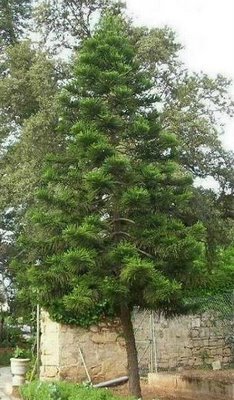Norfolk Island Pine

Norfolk Island Pine (Araucaria heterophylla) is one of the relatively few conifers of the southern hemisphere. It's reportedly capable of attaining 200 feet in height, but in most tropical areas, seldom exceeds half that. As a landscape tree, it grows ramrod straight with whorled branches arising at right angles to the main trunk. These swoop down in a graceful sweep creating a picturesque form for older trees.
A majestic tropical tree that originates from New Zealand, Araucaria excelsa is a marvellous foliage plant when carefully treated and not subjected to very high temperatures, which can be delilitating. Hot conditions cause normally turgid foliage to droop and become very thin. These elegant plants are best suited to important and spacious locations that will allow full development.

Araucaria excelsa
During early development plants should be allowed to fill their pots with roots before being potted on into slightly larger containers, using a loam-based potting mixture. When going into their final pots of 20 -25 cm diameter, the amount of loam should be increased to encourage slower but firmer growth. New plants can be raised from seed, but it is better to purchase small plants and grow them on. Few pests trouble these pines, but excessive watering, especially in poor light, will cause browning and eventual loss of needles.

A pine tree . . . that can be a houseplant. If you're looking for something green to add to a sunny room in your house, the Norfolk Island Pine (Araucaria heterophylla) is a perfect choice. It is easy to maintain, will grow to fit its container and surroundings, plus can double as a Christmas tree if desired. During the holidays, the Norfolk Island Pine is easy to find at garden and home improvement stores.
Special Care
Norfolk Island pines are considered easy plants to grow if you give them the right conditions. They prefer bright, indirect light, such as an eastern or western exposure where they will get one to two hours of sunlight a day. They do not require as much water as other common houseplants. In fact, they do not tolerate saturated soil. It is difficult to say how often a Norfolk Island pine will need watering.
Pot size, pot type, plant size, average room temperature, room lighting, and humidity all will influence the amount and frequency of watering. A good rule of thumb is to feel the soil. If it feels slightly dry to the touch, apply enough water to allow some to drain out the holes in the bottom of the container. Norfolk Island pines like the soil moist around their roots, but never wet. The lower limbs may turn brown and fall off if the soil is kept too wet or allowed to dry out. Other factors, such as low humidity levels and insufficient light, may also cause the lower limbs to drop off.
Norfolk Island pines do not require much fertilizer. Apply a soluble fertilizer with the watering every three or four months. Use the recommended rate on the label. They resent being repotted so only repot them every three or four years in the spring. Use a well-drained commercial potting soil mix and a container only slightly larger than the one it was growing in.
Avoid overpotting of young plants.






0 Comments:
Post a Comment
<< Home